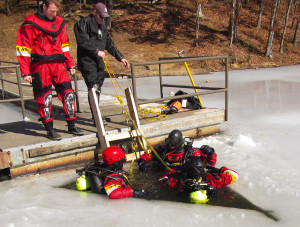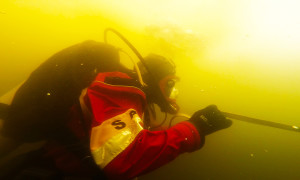By Chris Erwin
While most of us are wishing away the ice and snow members of the Ashland Fire Department decided to take advantage of the ice on Greenbo Lake. It was a perfect time to do some training. We usually think about firemen training how to fight a raging fire and while it is certainly a big part of their training, this week it was time to head below the six inches of ice still remaining on Greenbo Lake while they could. I was told they wouldn’t do this training unless there were at least four inches of ice on the lake. With warming temperatures last week they felt the time was right.
Battalion Chief Scott Boyd along with Captains Keith Salmon and Carl Stambaugh were the instructors. To begin, firefighters used a chainsaw to cut a small triangle hole in the ice to prepare for the ice diving exercise. Once the hole was cut into the ice the thickness of the ice was checked — eight inches — so they could cut a larger hole and begin their exercise.

Stambaugh told me that the hole was cut in a triangle shape because it was much easier to support yourself when you want to exit the water. The other members of the dive team were: Captains Chad Stevens and Jarrod Duncan, Engineers Anthony Cornwell, Dustin Charles and Evan Allison and Firefighters Mick Brown and Jared Chamberlin.
Each descending diver must be in full protective gear including instructors in full-face shields. Each would be tethered together in case of an emergency; which could include the malfunction of the air regulators or physical paralysis due to exposure. Stambaugh said, “While we are covered, our gloves are made from neoprene and the cold bleeds though in minutes. For that reason and other safety concerns dives are limited to 15 minutes at a time.”
The icy water became cloudy quickly as the silt is stirred up from the bottom making the visibly only a few feet. However, as each man dove below the surface they could look up to see the collecting bubbles becoming trapped under the frozen surface. These trapped bubbles can also make it hard to see the exit hole. With low visibly and sun defusing the light, it’s easy to see why safety is high on the list of things to learn.

It’s also necessary to be able to communicate in more ways than a radio or hand signals. Since someone becoming hypothermic may only have seconds to let the team know he is in trouble firefighters use a tug system to communicate. All the divers are tethered together and a single tug to their tether line means all is OK, two tugs is a signal to advance, three tugs take line and four tugs is a call for help.
These men are called upon to risk their lives for their community no matter if it is sunny and warm or wet and freezing. While most of us are running from a burning building, they are rushing into it. When a car careens over a hill and into the river it’s these men, regardless of the weather, that come to the rescue. Their training, physical ability and devotion to their job make me proud to call them my friends.
While we all are wishing to see our lakes become open again, this frozen time gave the AFD a chance to become a little better at being prepared to save a life in extreme circumstances. Until next time, keep a tight line and thank a firefighter for their service.



Be the first to comment